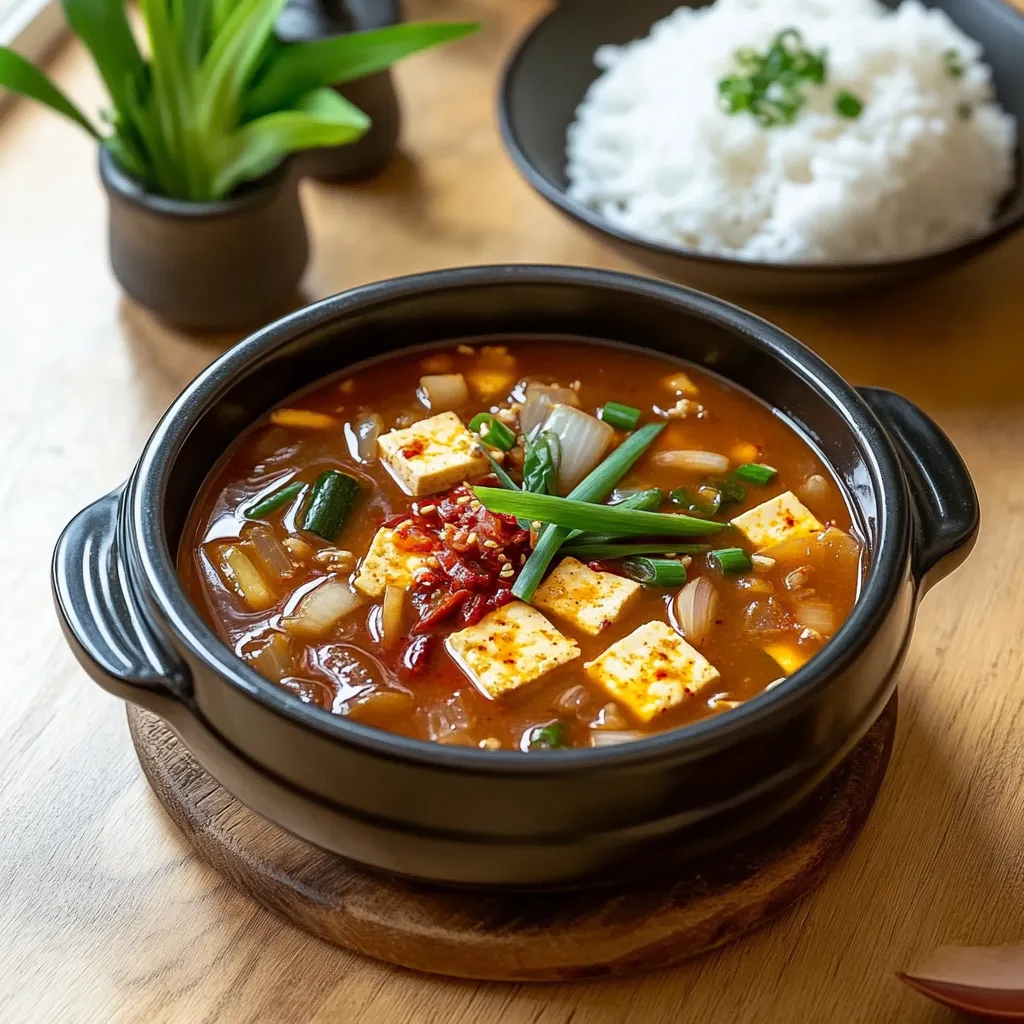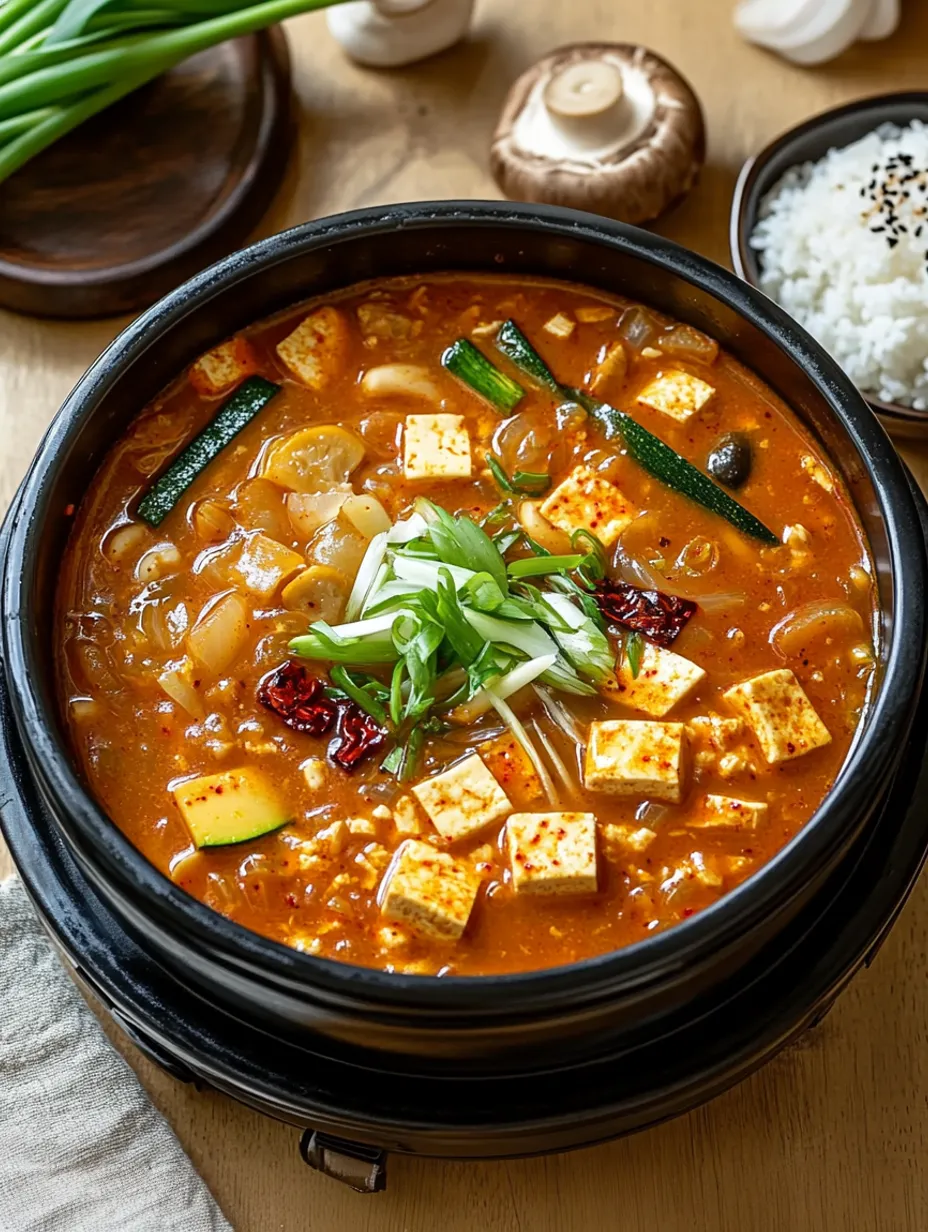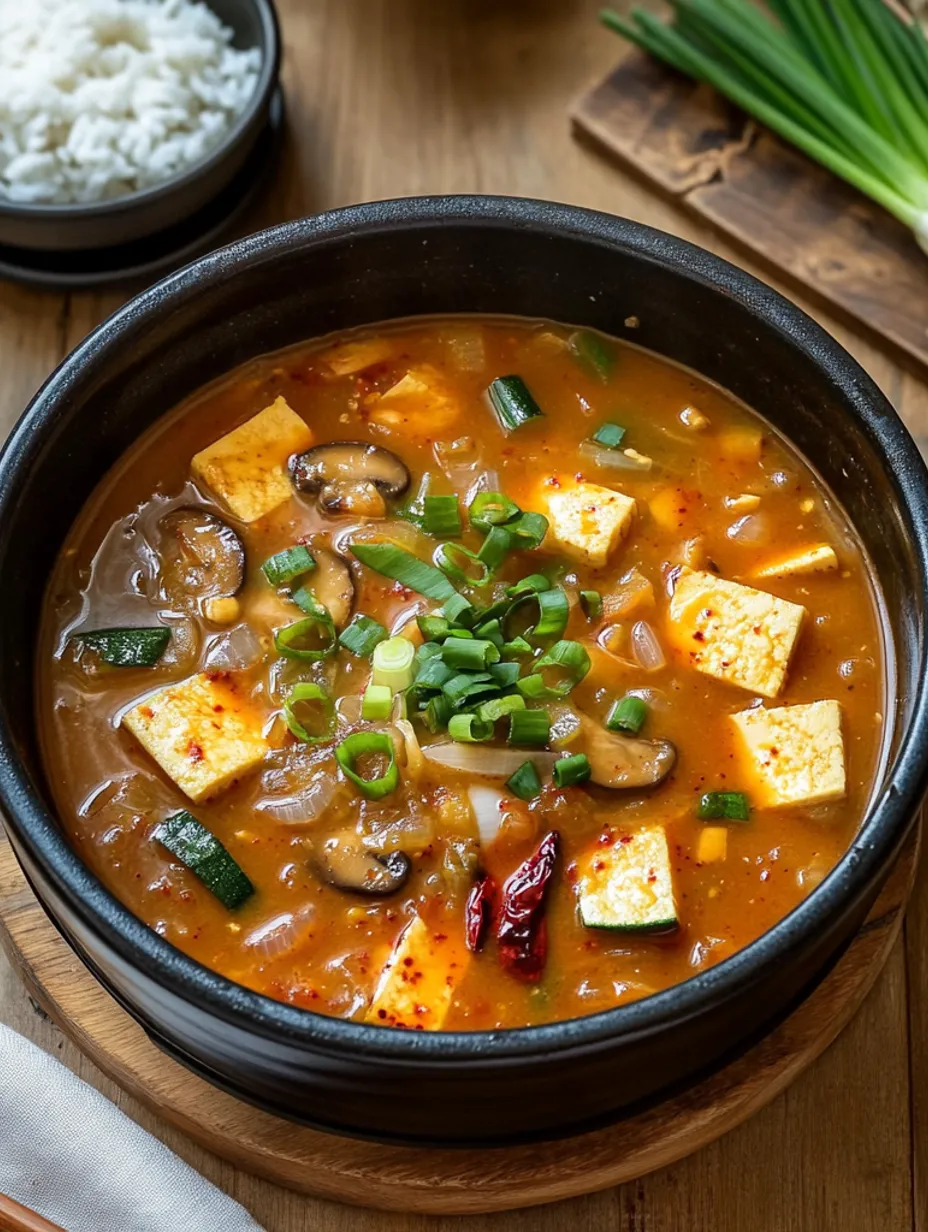 Pin it
Pin it
The first time I tasted Doenjang Jjigae was at a tiny Korean restaurant tucked away in my city's international district. It was a bitterly cold winter day, and I had ducked in seeking shelter more than authentic Korean cuisine. The owner, noticing my chattering teeth, suggested this soybean paste stew as something that would "warm me from the inside out." One spoonful of that rich, deeply savory broth with tender vegetables and silky tofu, and I was hooked. I've spent years perfecting my homemade version, calling my Korean friend's grandmother for tips, and I'm excited to share what I've learned with you.
I now make this stew at least twice a month in my home, more often during the winter months when its steaming goodness is especially welcome. My husband, who initially wrinkled his nose at the strong aroma of doenjang, has become such a convert that he requests it specifically when he's had a rough day at work. There's something about this stew that just makes everything feel a little better, a little more manageable. It's become our household's edible equivalent of a warm hug.
Simple Ingredients
Doenjang - The heart and soul of this dish. This fermented soybean paste may look unassuming in its container, but it packs an incredible umami punch that forms the backbone of the stew. Unlike its Japanese cousin miso, doenjang is chunkier, more rustic, and considerably more potent. You'll find it in any Korean market or well-stocked Asian grocery store, usually in a plastic tub. Once opened, it keeps for months in the refrigerator, so don't worry about buying more than you need for one recipe.
Anchovy Stock - The traditional base that adds another layer of depth. I use those convenient little tea bag-style anchovy stock packets (dasima and dried anchovy) that you can steep in water for 10 minutes. If that sounds intimidating or you can't find them, don't worry! Dashi, low-sodium chicken broth, or even vegetable broth will work beautifully. The doenjang is flavorful enough that your choice of stock won't make or break the dish.
Onion - Adds sweetness and body to the stew.
Zucchini - Provides a mild flavor and tender texture.
Green Onions - Used both for sautéing the white parts and as a fresh garnish for the green parts.
Mushrooms - These add an earthy dimension that complements the doenjang beautifully. Shiitakes are traditional, but cremini, oyster, or even regular button mushrooms work wonderfully too. Whatever you have in your refrigerator!
Tofu - Adds a silky protein element that soaks up all the amazing flavors of the broth. I prefer medium or firm tofu for this stew as it holds its shape better, but soft tofu creates a lovely, almost custard-like texture if that's your preference. Just handle it gently when stirring.
Garlic - Adds a pungent aromatic base.
Korean Chili Flakes (Gochugaru) - Round out the flavor profile with a subtle, smoky heat. If you don't have gochugaru, a pinch of regular red pepper flakes will work, though the flavor will be slightly different.
Neutral Oil - For sautéing the vegetables.
Optional: Sesame Oil - A touch at the end adds a wonderful aromatic quality.
 Pin it
Pin it
Easy Preparation
Create Your Flavorful BaseBegin by preparing your stock. If using anchovy stock packets, simply bring about 4 cups (approximately 950ml) of water to a simmer in a pot (ideally a Korean stone bowl called a dolsot if you have one, but any pot works fine) and steep the packet for about 10 minutes. Remove the packet and you've got your flavor base ready to go. If using another type of stock, just have it ready to pour in when needed. This step can be done ahead of time if you're planning ahead.
Ready Your VegetablesWhile the stock is preparing, dice one medium onion, slice one small zucchini into half-moons, chop two green onions (separating the white and green parts), and slice about 6-8 mushrooms. Cut one block of tofu into 1-inch cubes. If using any other vegetables, prep those too, cutting them into bite-sized pieces that will cook evenly. Having everything prepped before you start cooking makes the process smooth and enjoyable.
Build Your StewIn your pot or dolsot over medium heat, add about a tablespoon of neutral oil and sauté the onions until they begin to soften, about 2-3 minutes. Add 2-3 minced garlic cloves and the white parts of the green onions, cooking for another minute until fragrant. This brief sautéing step adds a depth of flavor that simply dumping everything in the broth won't achieve.
Create the MagicNow for the key ingredient! Add about 3 tablespoons of doenjang to the pot, stirring to coat the vegetables. Let it cook for about a minute, which helps to bloom the flavors. Then pour in your prepared stock, stirring to dissolve the doenjang completely. Add 1-2 teaspoons of gochugaru (adjust to your spice preference) and bring the mixture to a gentle simmer.
Layer in the Remaining IngredientsOnce simmering, add your zucchini, mushrooms, and any other vegetables you're using. Let these cook for about 5 minutes until they start to soften. Finally, gently add your tofu cubes, being careful not to break them. Simmer everything together for another 5-7 minutes until all the vegetables are tender and the flavors have melded.
Finish with FlourishJust before serving, scatter the green parts of your green onions over the top. If you like a bit more heat, a additional sprinkle of gochugaru adds both color and spice. For an extra touch of authenticity, I sometimes add a teaspoon of sesame oil at this point, which adds a wonderful aromatic quality to the finished stew.
I learned an important lesson about doenjang the first time I made this stew at home. Having watched countless YouTube videos where Korean cooks casually spooned the paste straight from the container without measuring, I did the same... and nearly created a salt bomb! Unlike some other pastes and sauces, doenjang can vary significantly in saltiness between brands. Now I always start with a conservative amount (about 2-3 tablespoons for a pot serving 4) and taste as I go, adding more if needed. The stew should be savory with a distinct umami character, but not overwhelmingly salty.
Perfect Pairings
This stew is traditionally served as part of a larger Korean meal with rice and various banchan (side dishes), but it's hearty enough to be a meal on its own when paired with rice. The simplest and most classic accompaniment is kimchi - its tangy, spicy crunch offers the perfect contrast to the rich, savory stew. I also like to serve some quick cucumber pickles for freshness, which you can make by simply tossing sliced cucumbers with a bit of rice vinegar, sugar, and salt. For a more substantial meal, this stew pairs beautifully with Korean barbecued meats. The rich, bold flavors of the stew complement the smoky sweetness of something like bulgogi (marinated beef) or galbi (marinated short ribs). If you're hosting a Korean barbecue night, having a pot of this stew bubbling away on the side makes the meal feel complete and authentic. I've also discovered that this stew makes an incredible breakfast, especially on cold mornings or when you're feeling under the weather. A small bowl of the stew with a side of rice and perhaps a fried egg on top is my idea of the perfect start to a winter day.
Storage Smarts
Like many stews and soups, doenjang jjigae actually improves with time as the flavors continue to develop. You can store leftovers in the refrigerator for up to 3-4 days, and I often find it tastes even better the next day. Just reheat it gently on the stovetop until bubbling. If you're meal prepping, I recommend making a larger batch of the stew but keeping the tofu separate until you're ready to eat. This prevents the tofu from absorbing too much of the broth and becoming overly salty. Simply heat the stew, add the tofu cubes, and simmer for about 5 minutes until the tofu is heated through. For longer storage, this stew freezes surprisingly well, though the texture of the tofu and zucchini will change slightly upon thawing. I sometimes freeze individual portions in small containers for quick emergency meals when I don't have time to cook. Thaw overnight in the refrigerator and reheat on the stovetop for best results.
 Pin it
Pin it
Chef's Wisdom
Flavor Building - For an extra layer of depth, add a splash of fish sauce or a piece of kombu seaweed to your stock. Textural Contrast - Add the zucchini later in the cooking process if you prefer it to maintain a slight crunch. Serving Vessel - If you have a Korean stone bowl (dolsot), use it! It keeps the stew bubbling hot at the table, enhancing the experience.
My journey with doenjang jjigae has been one of continual discovery and refinement. I remember being intimidated by making it the first time – worried about getting the balance of flavors right and whether my American palate would even appreciate this distinctly Korean dish. What I've learned is that this stew is incredibly forgiving and adaptable. It welcomes substitutions and adjustments to suit your taste and what you have on hand.
What makes this stew special isn't just its deep, complex flavor, but the feeling it evokes. There's something profoundly nurturing about a steaming bowl of doenjang jjigae on a cold day, or when you're feeling a bit under the weather, or even just when you need some culinary comfort after a long day. It's become my go-to remedy for almost anything – a true kitchen cure-all that nourishes both body and spirit.
Frequently Asked Questions
- → What is doenjang and where can I find it?
- Doenjang is Korean fermented soybean paste with a rich umami flavor. You can find it at Korean grocery stores, Asian markets, or online specialty shops.
- → Can I make this dish vegetarian?
- Yes! Simply use vegetable broth instead of anchovy stock and it becomes a delicious vegetarian meal.
- → What can I substitute if I can't find gochugaru?
- If you can't find Korean chili flakes (gochugaru), you can substitute with regular red pepper flakes, though the flavor will be slightly different.
- → What other vegetables can I add to this stew?
- Potatoes, spinach, radish, bean sprouts, and daikon are all common additions to doenjang jjigae.
- → How spicy is this stew?
- With 1 tablespoon of gochugaru, it has a mild-medium heat. Reduce the amount for less spice or increase for more heat according to your preference.
